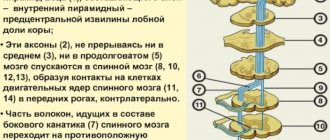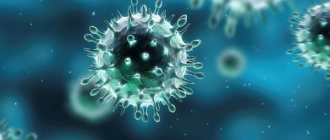Migraine is a pathological reaction of the blood vessels of the brain. Conventionally, the disease can be classified as cardiovascular. Accordingly, its complication can provoke a stroke, pathology of the cortex, and disrupt blood circulation.
Subsequent physiological damage to the brain can have the most unpredictable impact on human health, including in terms of psychology and neuralgia. So why is migraine dangerous and how can ignoring the symptoms of the disease end?
Convulsive attack
Migraine and epilepsy are two similar neurological disorders.
They can also accompany each other, and in this case a convulsive attack is caused by a migraine. Only special medications can relieve a seizure.
There are times when they don't work either. In such cases, the victim must be hospitalized immediately.
People with epilepsy almost always experience migraines before attacks. Only a fifth of all epileptics manage without headaches. The co-occurrence of migraine and seizures is called migralepsy.
This complication is difficult to treat. But it’s quite easy to recognize - the attack begins an hour after the headache begins.
How to warn them?
In order to avoid all of the above complications, you need to follow a few simple rules. At the first sign of any intensity headache, consult a neurologist.
Even if pills help you, you need to identify the cause of the pain, because it doesn’t just happen, and painkillers are not able to cure the cause, only relieving the symptoms for a while.
Therefore, you need to be fully examined by a doctor, undergo laboratory research methods (complete blood count, blood biochemistry) and instrumental diagnostic methods. After this, the doctor will make a diagnosis and prescribe appropriate treatment.
It is necessary to remember that if you follow all the doctor’s recommendations and prescriptions, you will not face complications . If any new symptoms occur, contact your doctor immediately to adjust the treatment and dosage of migraine medications.
source
Why do migraines occur?
To date, this disease has not been fully studied, but doctors can name provoking factors. Let's list the main ones:
Unbalanced diet.
- Problems with hormones.
- Consumption of alcoholic beverages and tobacco products.
- Constant stress, lack of sleep.
- Loud noise and smells.
- Excessive use of hormonal drugs.
- The following foods can trigger a migraine: smoked foods, sweets (chocolate), red wine.
A migraine attack is cyclical; the symptoms that arise are divided into three stages:
- The first phase - the patient has increased fatigue and loss of appetite.
- The second stage occurs in 30% of cases - this is a migraine aura.
It includes a set of neurological symptoms that occur during a painful attack, while the patient may feel: blurred vision, decreased sensitivity, changes in speech.
The final stage is characterized by a depressed mood and reluctance to live.
Signs
Each patient experiences an attack differently, because the symptoms of the disorder are as individual as its causes. There are four main stages of migraine:
- Harbingers. This phase can last several hours before pain occurs. Characterized by a depressive state, depression or, conversely, euphoria.
- Aura. It is manifested by visual, auditory, olfactory, tactile sensations that disappear with the onset of pain in the head.
- Headache. It is characterized by intensity and the ability to cover one or the other side of the head. Accompanied by light and noise sensitivity, drowsiness, nausea, lethargy. This is the longest and most exhausting phase. Some patients suffer from it for 2-3 days.
- Residual effects. During this phase, symptoms such as loss of appetite, fatigue, and depression are observed. It is during this period that a secondary migraine attack may develop.
Sleep and migraine
During the next migraine attack, many advise reducing negative triggers, lying down until the main symptoms pass, but it is better to try to sleep.
Not everyone understands why a migraine goes away after waking up. The answer lies on the surface, because during sleep the brain turns off and rests from active work, in addition to the brain, the vascular system rests.
To improve the general condition of frequent migraines, it is recommended to go to bed on time. The best option would be no later than 22 hours.
If you can’t go to bed at this time, you will need to go to bed until 12 o’clock at night. The specified time has a positive effect on the restoration of strength and accumulation of energy, which has to be used during the daytime. If you sleep later, you will have less energy.
In addition to falling asleep on time, it is recommended to rest from 8 to 10 hours a day. If sleep time is increased or decreased, the frequency of migraine attacks increases.
If you sleep after 00:00, then there is a high chance of a migraine after waking up, which will not go away over the next 24 hours. Sleep is one of the best ways to relieve symptoms of illness.
Doctors advise constantly sleeping on your back. This is the optimal body position to prevent the development of another attack.
If people sleep on their stomachs or in other uncomfortable positions, then attacks occur much more often. The main reason is that sleeping on your back puts your spine in the correct position.
In other situations, there is a possibility of contraction of the cervical muscles, after which the vessels are pinched, causing pain.
Migraine, what is its danger?
The word migraine is known to almost 95% of the country's population. Moreover, this condition haunts people quite often, and the reasons can be completely different.
But here a logical question arises: why is migraine dangerous? There are many negative consequences caused by this condition, and now we will talk about them in more detail.
REMEMBER! Do not forget that migraines will be more pronounced in people with bad habits. Alcohol, smoking, drugs - all this has a detrimental effect on human health.
Migraine and some facts about it
Migraine is an unpleasant throbbing pain in the frontotemporal region of the head. Of course, there cannot be any particular danger to life from the disease. But it can have a rather negative effect on your health. In medical terms, migraine is a functional disorder of vascular tone that is reversible. Next we will look at the consequences of migraines.
ADVICE! If you are sure that the headache is caused by a migraine, then it would be appropriate to take one of the anti-inflammatory drugs like aspirin. You should not endure a headache, as this can only significantly worsen your owl’s condition.
According to the symptoms and frequency of attacks, migraine is classified:
- Chronic form
- Migrainous status
- Migraine infarction
- Persistent aura without infarction
- Epilepsy attack
Chronic form
If headaches characteristic of migraine continue regularly for one month, then this is a good reason to consult a neurologist.
Chronic migraine can occur during prolonged and regular use of painkillers, as well as in patients experiencing depression. The headache can radiate to the temples, ears, eyes and back of the head. A doctor who will prescribe comprehensive treatment will help you avoid this condition.
Migrainous status
If headache attacks are recurrent and accompanied by vomiting and general malaise, the development of a migraine condition can be assumed.
In this case, the previous attack is repeated after four hours or does not stop at all for several days. Status migraine occurs in a small percentage of patients.
The characteristic features of this form of the disease are prolonged headaches for 72 hours with pronounced intensity.
Migraine infarction
Another condition dangerous to human health. For this condition, the characteristic symptoms are a migraine attack, which is accompanied by an aura with ischemic brain damage. This fact has been scientifically confirmed through research.
The main indicator of a migraine infarction is a migraine attack lasting more than 60 minutes. After the diagnosis, it becomes clear that a cerebral infarction occurred in the area corresponding to the clinical signs of the aura.
Persistent aura without infarction
In this case, aura symptoms contribute to cerebral vascular spasms. The duration of the unpleasant disease indicates cerebral ischemia, which is caused by insufficient oxygen supply.
An aura lasting more than seven days indicates that the body is experiencing a persistent aura without a heart attack. It is easy to distinguish this condition from a regular migraine - a persistent aura lasts continuously for one week.
Epilepsy attack
This condition occurs much less frequently than all of the above. Both migraine and epilepsy belong to a number of neurological ailments.
Most often, those who experience epilepsy attacks experience a headache characteristic of migraine. The percentage of such patients is approximately 60%, while there are only 20% of ordinary epileptics.
Very often, prolonged pain gradually develops into epilepsy.
The co-occurrence of epilepsy and migraine is called migrelepsy. This complication is quite difficult to cure. Migrelepsy can be recognized by the following symptoms: migraine with aura, an epileptic attack that occurs within one hour after the aura.
In order to exclude the development of migralepsy, you should carefully monitor your condition. If during a painful attack, prescribed pain medications do not provide any relief, you should immediately seek help from a specialist.
Migraine and sleep
Many people have a question: “Why does a migraine go away after sleep?” The answer is quite simple. At night, our brain rests from active activity, including the blood vessels in a state of rest.
It is recommended to go to bed no later than 10 pm. This time favorably contributes to the formation of energy that is needed during the day. Otherwise, less energy will be generated.
And if you go to bed late at night, then you can provoke a migraine for the whole next day. Sleep is considered the most effective remedy that helps get rid of the disease. But this only applies to night rest; after falling asleep during the day, many people will suffer from a headache throughout the day.
Experts recommend sleeping in a supine position, in which case the risk of migraines is eliminated. If a person is used to sleeping in an uncomfortable position or on his stomach, then attacks of the disease will not be uncommon.
The thing is that only when lying on our back, our vertebra is in the correct position. In other cases, incorrect posture can cause contraction of the neck muscles, resulting in pinched blood vessels and headaches.
ADVICE! To prevent the development of headaches, when in the sun, you should cover your head with a hat or cap and wear sunglasses over your eyes. Overheating and eye strain have been proven to cause migraine attacks.
IMPORTANT! You should distinguish between headaches caused by fatigue and those experienced from migraine attacks. Treatment of diseases is radically different from each other.
There are a number of indicators that are characteristic of this disease:
- Constant headache in the same area of the head (frontotemporal);
- Migraine is characterized by throbbing and increasing pain;
- Pain in the head area appears after physical exertion, stretching, and also during sexual activity;
- Vomiting, nausea, weakness appear, and sometimes the body temperature may rise.
Table: clinical characteristics of migraine and tension-type headache
Consequences
Is migraine life-threatening? After reading this article, we can say that in some cases this disease can cause dire health consequences:
- Status migraine – prolonged migraines, accompanied by vomiting, dizziness and general weakness of the body;
- Migraine infarction - a stroke develops against the background of prolonged migraine attacks that last for a week;
- Development of epilepsy against the background of aura.
The main symptoms of migraine include throbbing pain in the frontal and temporal zones, which can radiate to the ear, eyes and back of the head.
Remember that even a qualified specialist cannot determine the exact origin of a headache. You should undergo a series of diagnostics and clinical studies in order to find out the cause of the tormenting disease.
We wish you to remain in good spirits and never get sick!
Source: https://omigreni.ru/migraine/chem-opasna-migren.html
Psychological problems
Very often, the consequences of diabetes mellitus affect the human psyche. Firstly, the patient is not always ready to accept the news that he has diabetes. A person experiences all stages of adaptation to the disease. At first he denies the presence of the disease, anger and resentment, depression appear, after which he already adequately perceives his condition.
At the stage of denial of the disease, a person ignores the symptoms of its manifestation and stops visiting the doctor. When the diagnosis becomes obvious, he experiences resentment and anger, which is associated with the need for restrictions and the incurability of the disease. Gradually, the patient’s psyche adapts to the disease. A person makes concessions, but hopes for the influence of divine forces, after which he gradually plunges into depression, which is a natural reaction to difficulties. During this period, mood is reduced, apathy and indifference to the outside world appear. Then humility sets in, and the person learns to live in new conditions.
Diabetes continues to affect the mental state of the patient throughout his life. Patients often experience anxiety, sleep disturbances, autonomic disorders, and chronic depression. Moreover, cognitive disorders may occur, a change in the person’s personality, he becomes selfish, irritable and grouchy. Those people who are aware of responsibility for what is happening and are able to manage their illness perceive their illness more easily.
Main symptoms and stages of development
Migraine and other neurological disorders are diagnosed quite often in medicine.
Approximately 10% of the total population experiences migraine attacks, which can occur even in childhood. Women are most affected by the disease.
During the development of another migraine attack, patients may experience 4 stages of disease development.
The main phases of development are:
The appearance of harbingers or prodrome. This is the first stage, which occurs in half of patients with frequent migraines. The condition can be determined by changes in mood and irritability; there may be fatigue or depression. Signs appear several hours and even several days before the onset of the headache. There are patients in whom this condition is characterized by increased activity, for no apparent reason. In addition, appetite increases. Aura. The second stage of migraine appears in only 25% of migraine patients, but characteristic symptoms may not always develop. Aura is not considered a dangerous condition for a person and his health, but it does cause a lot of unpleasant sensations. The duration of the period is about half an hour, in some cases 1 hour. Characterized by visual impairment. The patient develops dark or light spots in the eyes, flickering and lines. In addition, other parts of the body or organs may be affected, resulting in tingling of the skin, difficulty with speech and motor activity. Pain syndrome. At this stage, headaches begin, of varying strength and duration. Duration from a couple of hours to several days. The attack gains maximum strength and affects one side of the head. The nature of the sensation is bursting, pulsating, and the intensity increases with movement. Additionally, the patient is accompanied by other symptoms: nausea, vomiting, fear of light, sounds, strong aromas. At the end of a migraine attack, symptoms and conditions similar to the first phase begin. When the main symptoms and headaches pass, weakness, depression, irritability sets in
Patients cannot concentrate, the stage lasts up to 24 hours.
Constant pain should be treatable, but for this you need to know the possible causes of the pathology. To reduce relapses, patients need to change their lifestyle and adhere to preventive measures.
Signs of disease danger
Migraines have the following danger signals:
- Persistent headache, mainly localized in the same place;
- The pain is increasing and throbbing;
- The pain is accompanied by weakness, nausea and vomiting;
- Migraines occur after strength training or stretching, as well as after sex;
- Fever.
Note! Do not mistake ordinary fatigue that provokes a headache for a migraine. You need to pay attention to the accompanying symptoms.
What causes migraine attacks
GENETICS
More than half of migraine cases are genetic. The most famous types of disease that are inherited are hemiplegic and ocular. Scientists have found that people with abnormalities in certain chromosomes are most likely to suffer from headache attacks.
For example, in the 19th. It is responsible for the functioning of the calcium channel passing through the brain. If any problems occur in this chromosome, then in half of the cases a person develops hemiplegic migraine.
Less often, but also quite often (in 20% of cases), the disease is caused by a malfunction of chromosome 1, which is responsible for the functions of the sodium channel.
And not so long ago, scientists discovered a region on the X chromosome that is also associated with attacks of throbbing headaches. Thanks to this discovery, it became clear why women (who, as is known, have two X chromosomes) suffer from migraines more often than men.
But scientists made a truly revolutionary discovery in the fall of 2010. Then experts discovered that any type of migraine can be the result of a mutation in the KCNK18 gene. These changes, scientists believe, make a person very sensitive to pain, including headaches.
Another interesting fact is that migraines are transmitted from parents to children in a higher percentage through the female line. If two parents suffer from severe headaches, then in 90 out of 100 cases their child will also suffer from migraines. If only the father has the disease, then the child’s risks are reduced to 20%, if only the mother has the disease, then they are approximately 70%.
The first migraine attacks most often occur at the age of 13-19 years, although there are often cases of the first headache attacks in children 5-6 years old, and in some migraines are diagnosed even at 2 years old.
As a rule, boys and girls under 12 years of age suffer from migraine pain in approximately equal numbers. After this age, the number of girls with migraines is approximately 2-3 times higher than the number of men with migraines.
In women, migraine more often occurs with an aura, and the peculiarity of an attack in the stronger sex is more excruciating pain during the attack.
Peak activity of the disease in men and women occurs between the ages of 25 and 34 years. After 40 years, the frequency of attacks decreases, and over time, for many, the attacks go away completely.
Another interesting discovery was recently made by Russian scientists. According to them, there is a connection between migraine and cardiovascular diseases. In the pedigree of migraine sufferers, relatives with hypertension are found 2 times more often than in people who do not suffer from headaches. And migraine sufferers themselves are more often diagnosed with hypertension than others.
FOOD AND DRINKS
A properly formulated diet for migraines can, if not completely eliminate headaches, then at least reduce their frequency and intensity. Wrong food, on the contrary, provokes attacks.
The most dangerous for migraine sufferers are red wine, champagne, citrus fruits, bananas, chocolate, aged cheese, smoked meats, sausages, sausages, and products with flavor enhancer E621 (monosodium glutamate). And this is not a complete list of products containing substances that can cause a headache attack.
Abuse of caffeinated drinks and then abruptly quitting them can also result in a painful attack.
It is equally important for migraine sufferers to maintain a healthy eating schedule (eat 4-5 times a day) and drinking regime (drink at least 1.5 liters of water per day), since hunger and dehydration are dietary triggers (provocateurs) of migraines. For this reason, many women who follow a strict diet experience increased headache attacks.
If a young lady who is losing weight eats dinner before 6 p.m., then she has every chance of waking up in the middle of the night with a severe migraine. The reason for this condition is a sharp decrease in glucose levels in the body.
For this reason, many women who follow a strict diet experience increased headache attacks. If a young lady who is losing weight eats dinner before 6 p.m., then she has every chance of waking up in the middle of the night with a severe migraine. The reason for this condition is a sharp decrease in glucose levels in the body.
Symptoms
The symptoms cannot be confused with anything - it is a throbbing and boring pain on one side of the head. Often discomfort occurs in the front and affects the forehead and temples.
The attack is also accompanied by sensitivity to loud sounds and light, nausea, loss of energy and drowsiness.
Migraine with aura is distinguished separately. The latter is a complex of symptoms-precursors - flickering of flies before the eyes, flashes of light in the field of vision and the appearance of blind spots. Such symptoms of visual disturbances are caused by a malnutrition of the optic nerve due to hypoxia (lack of oxygen in the tissues). As a rule, pain appears on average half an hour to an hour after the aura appears.
Patients often note that in addition to the aura, general irritability, loss of strength and drowsiness indicate an approaching attack. These symptoms also appear as a result of cerebrovascular accidents.
Chronic migraine manifests itself as regular attacks. They can happen on average once a month. If a patient has chronic migraine, he needs a consultation with a neurologist and a detailed examination of the brain to exclude a number of organic pathologies.
Hemicrania is not affected by blood pressure and is not a consequence of stroke or brain injury. This is a neurological disease in which the blood vessels, expanding, irritate the surrounding nerve endings.
The main symptom is a persistent, excruciating headache. Unpleasant sensations are localized in the area of the eyeball or temple, sometimes in the parietal region and spread throughout the head.
Usually the attack is accompanied by nausea, vomiting, dizziness, double vision and heightened perception of sounds and light. Symptoms begin to occur during puberty and can last for a long time.
In adulthood, attacks lose intensity and may disappear completely with the onset of menopause.
To prevent hemicrania from becoming chronic with complications, it is necessary to contact a neurologist for a full examination and prescribing adequate treatment.
Epileptic seizure
According to the morphological characteristics of diseases of the nervous system, the clinical picture of hemicrania is similar to epilepsy. In 6/10 patients, severe pain is diagnosed in different hemispheres. In 1/4 of cases, a diagnosis of hemicrania is made.
Loss of consciousness and seizures often occur due to this disorder. Such an attack occurs 60-90 minutes later, after the appearance of characteristic headaches.
Migralepsy is a neurological pathology manifested by a hybrid clinical picture between migraine and epilepsy.
In the case of a diagnosis of migrelepsy, the specialist focuses on the following signs: the symptoms of the aura are similar to classic hemicrania, an epileptic seizure appears 60-90 minutes after the disappearance of the aura. Course therapy is aimed at a comprehensive solution to problems: reducing blood pressure, alleviating the development of the disease.
Often the pronounced clinical picture of hemicrania is aggravated by seizures of epilepsy. Commonly available medications provide little benefit. The specialist will require immediate hospitalization of the patient, a comprehensive examination, followed by the prescription of drug treatment aimed at preventing anomalies.
Prolonged attacks of hemicrania result in negative consequences:
- development of pathologies;
- depression of the central nervous system;
- development of mental illness. A decrease in daily activity leads to destabilization in the field of career growth and general financial condition.
How to get rid of the problem
It is not possible to completely get rid of migraines, but a properly selected treatment regimen and lifestyle adjustments can reduce the intensity and frequency of attacks.
First of all, the patient needs a consultation with a neurologist and a series of examinations to exclude organic pathologies of the brain.
Once the diagnosis is confirmed, the neurologist will prescribe the necessary medications.
For treatment use:
- triptans - to relieve an attack;
- antidepressants - to reduce stress;
- sedatives to normalize sleep.
Triptans are a special group of drugs designed to relieve pain during a migraine attack. Such tablets do not help with other forms of headaches, as they do not have an analgesic effect. The drug should be prescribed by a doctor, depending on the characteristics of the disease in the patient.
Antidepressants are prescribed as an aid to patients with chronic migraines. These drugs help normalize the activity of the nervous system, improve the patient’s psycho-emotional state and relieve stress. Usually, for headaches, preference is given to herbal antidepressants. This is due to the minimum of side effects and contraindications.
Sedatives are used to normalize sleep and improve work ability. They inhibit the activity of the nervous system, so they should be used strictly before bedtime. As a result of such therapy, the quality of sleep improves, the destructive effect of stress on the functions of the nervous system is reduced, as a result of which patients note an increase in performance.
A few words about the pathology itself
Before we talk about why diabetes mellitus is so terrible, we need to say a few words about the mechanism of its development. And for this you need to consider its types. So, diabetes mellitus happens:
- The first type. It is characterized by damage to pancreatic cells and disruption of their insulin production. But it is this hormone that is responsible for the breakdown and absorption of glucose. Therefore, when there is a shortage of it, sugar does not penetrate the soft tissue cells and begins to settle in the blood.
- The second type. This disease is characterized by normal functioning of the pancreas and sufficient levels of insulin in the body. But for some reason, the cells of soft tissues and internal organs begin to lose sensitivity to it, so they stop absorbing glucose, as a result of which it begins to accumulate in the blood.
- Gestational. It is also called pregnancy diabetes, since it is with the development of gestasis that it forms. It is also characterized by an increase in blood sugar levels, but not because the cells of the pancreas are damaged, but because the amount of insulin that it produces is insufficient to supply the body of the woman and her child. Due to a lack of insulin, sugar begins to be processed much more slowly, so most of it settles in the blood. Gestational diabetes is considered a temporary disease and goes away on its own after childbirth.
There is also another concept - diabetes insipidus. Its development occurs against the background of insufficient synthesis of antidiuretic hormone (ADH) or as a result of decreased sensitivity of the renal tubules to it. In both the first and second cases, there is an increase in urine output per day and the appearance of unquenchable thirst. There is no increase in blood sugar levels with this disease, which is why it is called sugar insipidus. However, the general symptoms are very similar to regular diabetes.
Considering that diabetes has different types, the consequences of their development are also different. And in order to understand the dangers of diabetes mellitus, it is necessary to consider each of its types in more detail.
Diabetes mellitus is fraught with many complications, but if treated correctly, they can be avoided
Major complications
So, why is pathology dangerous? The main consequences can be considered:
Transition to chronic form. Chronicity is typical for patients with depression or who use excessive amounts of painkillers. The diagnosis is made by a neurologist if the patient complains of an increase in the frequency of attacks and the duration of their manifestations totaling more than 15 days per month. In the chronic form, the pain intensifies, the pain can spread throughout the entire head area, radiating to the temples, jaw and eye sockets.
Migrainous status. Migraines, especially in women, can provoke attacks with intense headaches that last longer than regular migraine attacks. In this case, they speak of migraine status. In what cases is the diagnosis made: severe headaches are accompanied by other symptoms: profuse repeated vomiting, disorientation, visual disturbances and other neurological disorders;
the attack lasts more than 72 hours, and no medicine brings relief; During one migraine attack, short-term periods of relief are observed, but they last no more than 4 hours, more often less
When making a diagnosis, it is important to exclude the presence of other diseases that can provoke the above symptoms.
Persistent aura without a heart attack The sensation of an aura before an attack is already a complication of the disease, but its persistent or chronic form, which is characteristic of the classic form of migraine, is especially dangerous. To identify this condition, pay attention to the duration of the aura - in a chronic course, several symptoms or one sign over the course of a week predicts the onset of an attack. It has been established for certain that during an aura, the patient’s brain experiences a deficiency of oxygen and nutrients, signs of ischemia are observed, and the manifestations of neurological disorders intensify, but the brain tissue remains intact if treated in a timely manner. In the absence of necessary therapy, the condition is dangerous due to the development of hemorrhagic stroke or infarction of brain tissue.
Migraine stroke. Classic migraine attacks with aura gradually lead to a decrease in vascular tone, which subsequently causes the development of ischemic lesions and, as a consequence, stroke. Differences in migraine stroke: there are no other reasons that could influence its development; Symptoms characteristic of a migraine attack may still be observed for an hour;
history of two or more migraine attacks with aura; during the week before the stroke, the aura symptoms disappeared and then reappeared
With a migraine stroke, one or more areas of the brain are affected, and in those areas on which neurological signs depend. Very often, the consequences of migraine and stroke remain in the form of persistent neurological disorders.
Migrelepsy. The simultaneous occurrence of migraine and epilepsy is considered a serious neurological disorder. Characteristic signs: an epileptic seizure is preceded by precursors of a classic migraine; development of an epileptic seizure 1-2 hours after the end of the aura;
migraine symptoms are relieved with anti-epileptic drugs. Sometimes, when migraine attacks are too severe, the development of an epileptic seizure begins: the patient’s brain experiences persistent hypoxia and, without timely hospitalization, irreversible brain damage may develop.
Migraine is an extremely severe and insidious pathology. It is dangerous not only due to the appearance of extremely unpleasant sensations, but also the development of severe consequences that can lead to irreversible changes in the brain. Therefore, the pathology can and should be treated without causing severe exacerbations.
Consequences of migraine: what is the threat of the disease, is it possible to die from it, why is it dangerous for human life?
If you look at the statistics, you will know that about 10-13% of the world's population suffers from migraines. It is usually observed in young women (35-40 years old).
This disease is quite serious, as it significantly reduces the quality of life of people suffering from it. During an attack, the patient is forced to give up everything, because the pain of a migraine is unbearable and impossible to endure.
What are the consequences of migraine, what the disease threatens, whether people die from it - you will find answers to these and other questions in the article.
How dangerous is the disease?
Migraine attacks last from several minutes to several hours, or even days . At this time, patients experience intense headaches, mostly unilateral, which can change their location. That is, it hurts, either the right or the left half of the head.
The pain is accompanied by photophobia and intolerance to loud sounds, which forces the person to isolate himself from everyone in a closed, dark room for the duration of the attack.
Migraine itself is not dangerous . However, you need to know all the complications that it brings with it. In order to understand this, you need to understand the pathogenesis of the disease, that is, what happens in the body during a migraine. These headaches are associated with the expansion and then narrowing of blood vessels in the brain.
While the blood vessels narrow, the brain structures do not receive sufficient blood supply. That is, an ischemic zone is formed, this zone slowly moves through all lobes of the brain, because of this the pain changes its localization. Lack of blood circulation lasts about 4-6 hours, which is quite dangerous for the brain .
It is known that the brain receives nutrients and oxygen along with blood; in the absence of them, the brain simply has nothing to eat. With prolonged fasting, serious complications can occur.
Complications and consequences
But is it possible to die from a migraine, is the disease dangerous for human life? Migraine itself does not pose a threat to human life, but it can cause dangerous complications and become chronic. The dangers of chronicity of this type of headache will be described below.
Chronic form of the disease
Migraine can be called chronic if the pain lasts 15 or more days a month , which leads to the patient being unable to lead a normal active lifestyle. In order not to progress your disease, you need to be thoroughly examined by a neurologist by undergoing additional examination methods.
These include CT and MRI of the brain, ultrasound of cerebral vessels, radiography of the skull and spine. Since migraine often becomes a concomitant disease with any other pathologies that increase the intensity of the headache.
Chronic pain can become due to the abuse of medications that relieve headaches. This happens in cases where people suffering from migraines do not go to a specialist, but prescribe treatment for themselves. Often it is incorrect, so it does not bring relief during attacks, as a result of which patients use more and more medications.
Also often, by mistake, patients take conventional painkillers, including Analgin and its derivatives . The use of analgesics can only temporarily relieve a common headache.
Since migraine pain is associated with a lack of blood circulation in various areas, ordinary analgesics will not help here.
Migraine stroke
This is an acute disorder of cerebral circulation that is caused by paroxysms during migraine.
One of the most dangerous complications. Occurs in case of prolonged lack of blood circulation in the brain. This occurs with frequent migraine attacks, status migraine, and long-lasting migraine.
An ischemic zone forms in the brain due to a prolonged lack of blood in a certain area, which causes this area to die.
The course of a migraine stroke is exactly the same as the aura before a migraine attack . Only lasts for a long time (more than one hour), because of which patients may mistakenly believe that this is a regular migraine attack and do not consult a doctor. Which brings additional negative consequences.
Also, over time, neurological symptoms characteristic of cerebrovascular accidents are observed: speech impairment (speech is intermittent and incomprehensible, or its absence), decreased sensitivity, impaired motor function (mono, hemi or tetraparesis, plegia).
In almost 85% of cases, visual impairment will be observed . Among them: diplopia - double vision, hemianopsia - loss of vision. In some cases, loss of consciousness may occur.
Persistent aura
This is the occurrence of two or more auras during an attack . The aura is characterized by the presence of visual and olfactory disturbances, and nausea.
Pathological symptoms such as spots before the eyes, darkening, bright flashes of light may occur. Also in some cases, visual hallucinations occur.
After a migraine attack with aura, patients often describe them and even draw them to show the doctor.
Why a persistent aura occurs is still completely unknown. As, in principle, are the true causes of migraines.
The cause may be heredity, when your loved ones had a similar disease and auras. A persistent aura may also occur as a complication.
Convulsive attack
Another equally dangerous complication of migraine. It can occur during migraine status, when the patient does not stop vomiting for a long time . This leads to the loss of electrolytes in the blood through vomit, the lack of which causes dehydration. As a result, the patient experiences convulsions.
It is important to help patients who have developed a seizure by placing them on a flat surface and removing all objects that surround them. Do not hold limbs under any circumstances, as this can lead to fractures and injury.
How to warn them?
In order to avoid all of the above complications, you need to follow a few simple rules. At the first sign of any intensity headache, consult a neurologist.
Even if pills help you, you need to identify the cause of the pain, because it doesn’t just happen, and painkillers are not able to cure the cause, only relieving the symptoms for a while.
Therefore, you need to be fully examined by a doctor, undergo laboratory research methods (complete blood count, blood biochemistry) and instrumental diagnostic methods. After this, the doctor will make a diagnosis and prescribe appropriate treatment.
It is necessary to remember that if you follow all the doctor’s recommendations and prescriptions, you will not face complications . If any new symptoms occur, contact your doctor immediately to adjust the treatment and dosage of migraine medications.
Source: https://nerv.guru/zabolevaniya/migren/posledstviya-m.html
Epileptic seizures
Migraine, as a neurological pathology, has a close relationship and similar symptoms of attacks with epilepsy. In 60% of cases, patients with epilepsy experience systematic headaches, and in 25% migraines are diagnosed.
In most cases, migraine is a factor that provokes an attack of epilepsy. The attack begins with a migraine aura, which ends when the pain syndrome develops. An epileptic seizure in this case begins 1-1.5 hours after the onset of headaches and associated symptoms typical of migraine.
In medicine, a hybrid attack of migraine and epilepsy was classified into a separate neurological pathology - migrelepsy. The main criteria for migralepsy when making a diagnosis are:
- symptoms of aura, characteristic of classic migraine; the appearance of an epileptic attack approximately an hour after the disappearance of the migraine aura; the effectiveness of anticonvulsants in relieving migraine pain, restoring blood pressure and relieving unpleasant symptoms such as nausea and vomiting.
Feel free to ask your questions right here on the website. Write >>
Prolonged migraine attacks are fraught with other unpleasant consequences. A person who constantly experiences excruciating migraine pain is more susceptible to exacerbation of chronic pathologies and psycho-emotional disorders. A decrease in physical and mental activity leads to troubles at work and, accordingly, in the financial sphere.
The information on the site is created for those who need a qualified specialist, without disturbing the usual rhythm of their own lives.
Constant migraine (hemicrania) affects a person’s quality of life, keeps them under constant stress and can lead to serious consequences. Migraine is a type of headache that can be with or without an aura. The disease with aura is accompanied by visual disturbances, including loss of vision. But this is not the only danger of migraine. Among the complications of frequent attacks are the transition of an ordinary headache into a chronic process, status migraine, persistent aura without a heart attack, migraine infarction, and an epileptic attack.
You need to be wary when you have a headache several days a week or every day, the duration of each subsequent attack increases, and symptoms of cerebrovascular accident appear. The consequences of migraine can be prevented only by its constant treatment, prevention of complications and maintaining general health. Let's look at the dangers of migraine without treatment and how each complication manifests itself.
Migrainous status
One of the most “popular” complications is status migraine.
It presents as continuous pain that lasts up to three days in a row.
A throbbing and growing headache is often accompanied by severe vomiting, which makes it difficult to take medications.
Vomiting causes the body to become severely dehydrated. A person's vision is partially impaired and dystonia occurs. All this may be accompanied by a foggy consciousness.
The person falls into apathy, fainting from time to time. Movement becomes difficult due to pain, and may also be accompanied by convulsions.
General characteristics of the condition
Tachycardia is characterized by a violation of heart rhythm - increased frequency. The human heart in a normal state should contract 80 times per minute in a supine position and 100 times in a standing position. If this norm is exceeded, tachycardia is diagnosed. There are two main types of this deviation:
- The physiological form does not pose a threat to health and life, since the heartbeat increases after physical exertion, at high body temperature, in stressful situations, and during emotional outbursts. This is considered the norm.
- Pathological form. In this case, accelerated contraction of the heart muscle is observed without reason, even in a calm state. This form poses a threat to the patient's life.
With pathological tachycardia, additional symptoms appear: weakening of the body, fatigue, decreased appetite, loss of strength, insomnia, dizziness.
The following factors can cause the formation of tachycardia:
- disruption of the functioning of the endocrine system;
- deviations of a vegetative nature;
- infection and intoxication of the body;
- drinking alcoholic beverages and smoking;
- some diseases of the heart and circulatory system;
- anemia;
- respiratory diseases.
Find out from our video about the main causes of tachycardia. This will prevent the development of the disease:
Frequent attacks: how dangerous are they for the patient’s health?
A chronic neurological disease that causes headaches every week cannot be caused by other pathologies in the patient’s body. But they can provoke the development of such complications:
- Status migraine – severe migraine attacks alternating one after another. Often this includes prolonged pain that lasts longer than three days. Pain sensations spread to the entire head. They are bursting in nature. Since a severe attack causes vomiting, patients become dehydrated. Severe weakness sometimes leads to convulsions, in which case it requires hospitalization of the patient.
- Migraine stroke is a dangerous form of neurological disease. It is called a catastrophic form of migraine. In this case, patients suffer from symptoms that are not characteristic of a normal migraine attack. Neurological disorders appear, which appear and then disappear.
The consequences of chronic migraine disrupt the patient's life. Studies have shown that those patients who are bothered by frequent attacks are characterized by the presence of the following ailments:
- The presence of chronic diseases, general weakness of the body;
- Depressive states, anxiety;
- Material disadvantage due to disability and, accordingly, all the consequences of low economic security.
We can conclude that episodic migraine does not pose a threat to the patient’s life. But complicated forms of the disease significantly reduce its quality.
Why is chronic migraine dangerous?
It is not uncommon to exclaim “I have a migraine!” is perceived by ignorant people as a theatrical gesture, a feminine trick. In fact, this disease brings genuine torment to its victims.
This is a chronic disease, and indeed women are more likely to suffer from it. It is expressed in severe throbbing pain, usually covering one half of the head, sometimes the entire head.
The torment continues for several hours, and sometimes even days.
During the attack, the patient does not experience any surges in blood pressure, intracranial pressure is also normal, there are no signs of stroke, there is no head injury or brain tumor. However, chronic migraine, due to the nature of intense throbbing pain, is classified as a vascular disease, and not as a consequence of overexertion and fatigue.
Causes
The real reason is still unclear to medicine. The disease is associated with abnormal brain activity, with increased sensitivity of the intracerebral arteries, which during an attack causes them to spasm and further excessive expansion. The exact chain of events remains unclear.
Medical experts generally believe that the attack, which begins in the brain, involves neural pathways and chemical processes. This causes changes that affect blood flow in the brain and surrounding tissues. Frequent migraines cause vascular changes in susceptible people.
They can be triggered by certain situations or events:
- intoxication
- stress
- anxiety
- certain perfumes and other odors
- loud sounds
- bright light
- heavy smoking
There are several types of the disease. You need to have a good understanding of the symptoms of migraine in order to correctly diagnose the disease and prescribe the right treatment. For example, treatment for cervical migraine differs from other types. You can read more about it at this link.
Risk factors are very individual. For some, they are caused by intolerance to certain foods or certain types of alcohol.
Another will completely calmly consume these products, and his attacks will be caused by lack of sleep or oversleeping. For some, a change in weather conditions will be a favorable background.
For many, hormonal causes of attacks are important, for example, taking contraceptives or simply the menstrual cycle.
Often the decisive cause of the disease is not one factor, but a combination of several.
Symptoms
The main symptom is a throbbing headache. It can also be bursting or shooting. It can torment a person incessantly or be paroxysmal.
Frequent accompaniments of severe pain: visual disturbances, nausea, vomiting. Visual impairment is expressed in the appearance of a halo around a light source, distortion of the outlines of objects.
Most often, symptoms begin to occur during puberty. The peak of attacks occurs in mid-life. Then the disease begins to lose ground and often disappears without a trace.
To prevent migraine from developing into a chronic disease, if symptoms occur, it is necessary to undergo an examination by a neurologist.
Harbingers
There are two main types:
- ordinary, also known as migraine without aura;
- classic, known as migraine with aura.
An aura is a complex of signals with which the body, as it were, warns: an attack is about to begin. Typically, an aura is associated with symptoms that cause blurred vision:
- flashes of light, zigzags, spirals and other annoying visions begin to flash in the eyes;
- Lights and sounds can be extremely annoying and movement can be painful.
Usually migraines occur suddenly, but sometimes sufferers experience fatigue and depression, and sometimes unhealthy cravings for sweets.
This is the so-called aura stage preceding the attack. It can last from four to five minutes to an hour.
One-seventh of patients suffer from classic migraine with aura.
Why is migraine dangerous?
It is not the source or cause of other diseases. But it is dangerous for its complications: migraine status and migraine stroke.
- Status migraine is a chain of severe attacks following one another. It can also be one extremely long (more than three days) and severe attack. Localized in one half of the head, the pain flows into the entire head and becomes bursting. Frequent vomiting occurs, which often leads to dehydration. The resulting severe weakness can lead to seizures. Migraine status requires hospitalization.
- Migraine stroke is called a “catastrophic” form of migraine. It is accompanied by the development of various neurological symptoms that are not typical for migraine patients. Neurological symptoms have a “flickering character” - they appear and then disappear.
A migraine attack cannot always be relieved with medications. For example, not all medicines are suitable for treating headaches during breastfeeding, and there are also many restrictions during pregnancy (they are written about here).
Migraine stroke is diagnosed only in the following cases:
- the patient suffers from classic migraine with aura;
- a migraine stroke manifests itself in the same way as a “regular” migraine attack in this patient;
- during a migraine stroke, the attack is necessarily accompanied by “flickering” symptoms;
- Computed tomography reveals characteristic changes in the brain.
What to drink for migraines?
The following drugs are recognized as the most effective medicines:
- Ergotamine. Contains ergot alkaloids, the effect is aimed at narrowing blood vessels (mainly arterioles) and reducing the volume of blood entering the brain. It must be taken at the very beginning of the attack or during the aura period.
- Amityriptyline. It is more of an antidepressant than a pain reliever. However, it acts on some provoking factors (stress, regulates mood, improves sleep) and has proven itself in relieving attacks.
- Bellegral. It contains belladonna alkaloids and barbiturates (phenobarbital). The effect of the drug is sedative (calming) and suppressive on nerve endings (parasympathetic and sympathetic).
All drugs have side effects, so you should not “self-prescribe”. What to drink during a migraine - decide with the help of a neurologist.
Source: https://www.neuroplus.ru/bolezni/migren-golovnaya-bol/chem-opasna-hronicheskaya-migren.html
Complication
The modern dynamics of life do not allow the nervous system to relax, which creates the preconditions for the occurrence of severe, prolonged attacks. Let's consider why migraine pain is dangerous and what consequences it can lead to. Complications of the disease are:
- migraine status;
- migraine stroke;
- chronic hemicrania;
- persistent aura without infarction;
- epileptic seizure.
A condition characterized by a series of migraine pain attacks accompanied by vomiting, dehydration, and loss of strength. The deterioration of the condition may continue for several days, while the pain syndrome is not relieved by traditional medications and is steadily increasing.
A localized headache turns into a headache that covers the entire head, acquiring a bursting character. During an attack, cerebral edema may appear due to prolonged hypoxia. Treatment requires a qualified approach, a comprehensive examination and urgent relief of the attack.
Migraine stroke or the so-called “catastrophic” form of hemicrania is manifested by migraine with aura and ischemic damage to the blood vessels of the brain. Neurological symptoms increase and then regress for several hours, after which they return to the patient. The criteria for a heart attack (stroke) are:
- identification by neuroimaging methods (computed tomography, EchoEg) of changes leading to ischemia;
- a history of classic migraine accompanied by an aura with several symptoms (dizziness, blurred vision, etc.);
- cerebral ischemia is not associated with other factors;
Chronic hemicrania
A small percentage of patients suffer from headaches without an aura lasting 15 or more days per month over a long period. In this case, a neurologist can diagnose chronic migraine.
Prevention of any disease is very important
Several factors are to blame for the development of episodic pain into chronic pain: uncontrolled use of painkillers and depression. The disease significantly reduces the quality of life, contributes to an increase in financial costs and maladjustment of patients.
The headache can radiate to the eyes, back of the head, and upper jaw. The only way to combat the disease is timely relief of attacks and preventive measures.
Persistent aura without infarction
Persistent aura without ischemia is a long-lasting aura without damage to cerebral vessels. Diagnostic criteria for the disease:
- migraine with aura is typical and differs in that several symptoms of aura occur continuously over 5-7 days;
- There is no history of other causes of poor health.
Is migraine dangerous without vascular damage? This is a question with a clear answer. A prolonged aura indicates prolonged oxygen starvation of brain cells. And this in turn leads to loss of vitality, weakening of memory and nervous disorders.
Epilepsy attack
Migraine and epilepsy are neurological disorders united by a number of signs: increasing symptoms during the attack period, normal neurological status in the inter-attack period, positive dynamics during drug treatment.
These two ailments are often interrelated and accompany each other. Migraine is usually a precursor to a seizure.
If medications intended to relieve attacks do not have the desired effect, then urgent hospitalization is necessary. Only in a hospital setting can antihypoxic measures and high-tech studies be carried out to make a diagnosis. And only in this way can complications of migraine combined with epilepsy be prevented.
Causes
The disease is based on dysfunction of neurotransmitter systems with improper regulation of cerebral vessels. Status migraine is the result of intractable migraine attacks.
The main causes of the disease are:
- lack of treatment in the early period of an attack;
- ineffectiveness of drugs;
- addiction to a particular drug.
Often the cause of a severe attack is self-medication, when the patient does not seek help from a specialist. It is difficult to choose treatment remedies on your own, since they will be different for each form of the disease.
Risk factors for developing status migraine:
- taking hormonal medications and antidepressants;
- lack of sleep, dehydration;
- suffered severe infections;
- change in weather conditions;
- strict diet, feeling hungry;
- hormonal imbalances in the body, which often happens during pregnancy;
- traumatic head injuries.
The reason may be a sudden change in medications. In this regard, it is not recommended to independently make a decision about stopping medications and switching to others.









